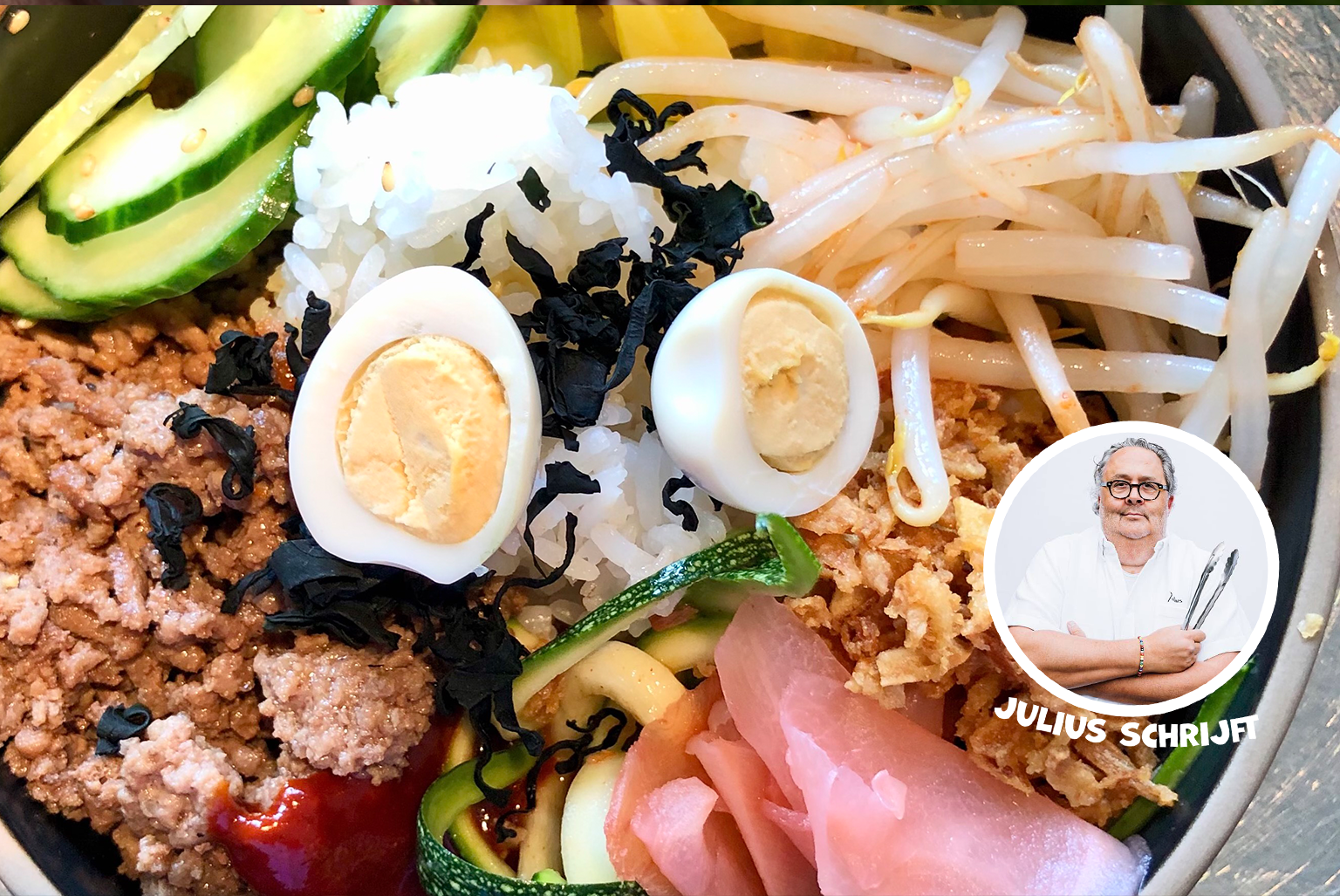Today I am inspired by the wonderful journey that Ron and his daughter just made through Korea and Japan, with a bibimbap recipe. Bibimbap is a Korean dish with rice, beef, vegetables, kimchee, raw egg and gochujang sauce in the base, and then you can add all kinds of condiments.
The first time I ate a bibimbap happened to be with Ron at the Eldorado restaurant in Copenhagen (we’re talking 2016) and I was instantly in love. After returning home I started tinkering and trying it out and included one in my oh-so-fun cookbook Oriental Streetfood. Later I made another 2000 (no joke) during Ferry’s Chill & Groove, the annual music-food festival of the Bosch in Amsterdam. I love the stuff, like many dishes from the Korean kitchen.
The success of a super tasty bibimbap always lies in the very best basic ingredients, as is the case with any dish, but now also specifically in the temperature, it should certainly not be too cold. Just like with the poke bowl, a bibimbap should not be stone cold, the same applies to sushi rice. The rice must be at least room temperature, but may also be lukewarm, and the condiments warm (meat), lukewarm (vegetables) or cold.
Bibimbap
6 people
150 g gochujang (Korean chili sauce)
3 tbsp sesame oil
1 tbsp honey
5 tsp sugar
1 tbsp Korean apple cider vinegar (or rice vinegar)
400 g white rice, cooked
3 tbsp sunflower oil
200 g minced beef
1 tbsp Kikkoman soy sauce
seaweed, dried and in strips
100 g bean sprouts, blanched for 30 seconds and rinsed cold
1 tbsp sriracha
100 g zucchini, in long strings (spaghetti)
100 g kimchee, ready to use
sesame seeds, toasted
6 tbsp fried onion, ready to use
3 tbsp Japanese ginger
3 tbsp marinated Japanese radish, cut into sticks
6 quail eggs, boiled and peeled
1. Mix gochujang with 1 tablespoon of sesame oil, honey, 2 teaspoons of sugar and apple cider vinegar to make the bibimbap sauce
2. Season the rice with 1 tablespoon of sesame oil and 2 tablespoons of sunflower oil.
3. Fry minced meat in 1 tablespoon of sunflower oil, and season with 1 teaspoon of sugar and soy sauce.
4. Mix bean sprouts with sriracha and let it soak.
5. Mix zucchini with 1 tablespoon of sesame oil and leave to soak.
6. Fill a bowl with rice and place minced meat in a ring, seaweed, bean sprouts, zucchini, kimchee, sesame seeds, fried onion, Japanese ginger, Japanese radish and bibimbap sauce. Place a sliced quail egg in the center.
If you feel like cooking further, or if there is no good kimchee in stock, make it yourself. Not difficult, just a matter of planning and patience. The recipe below is from David Chang (Momofuku). Cucumber kimchee can be stored for a few weeks, it only improves in taste and smell.
Cucumber kimchee
500 g cucumber
40 grams of sugar
1½ tsp sea salt
1½ tbsp ginger, in thin strips
4 garlic cloves, sliced
15 ml fish sauce
15 ml usukuchi (soy sauce)
1 carrot, in matches
1 spring onion, in matches
¼ red onion, sliced
1 tbsp kochukara (chili powder)
1. Cut the cucumber and mix with a quarter of the sugar and a quarter of the salt.
2. Let stand in a colander for 10 minutes.
3. Mix the rest of the sugar and salt with kochukura, ginger, garlic, fish sauce and usukuchi and add carrot, spring onion, onion and cucumber.
4. Leave to ferment in the refrigerator for at least a day (fermentation goes faster outside the refrigerator).








